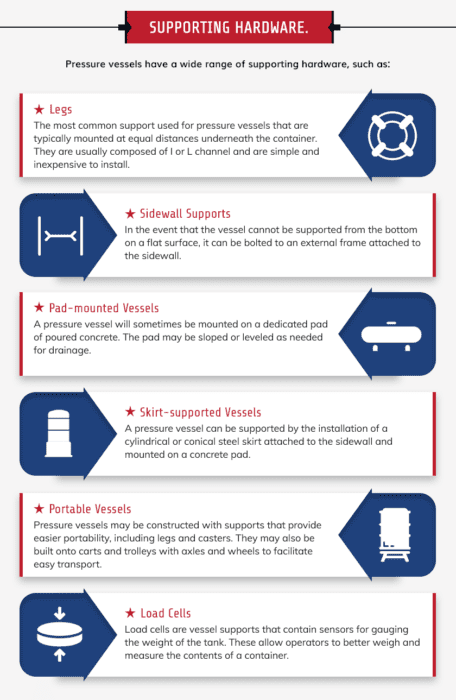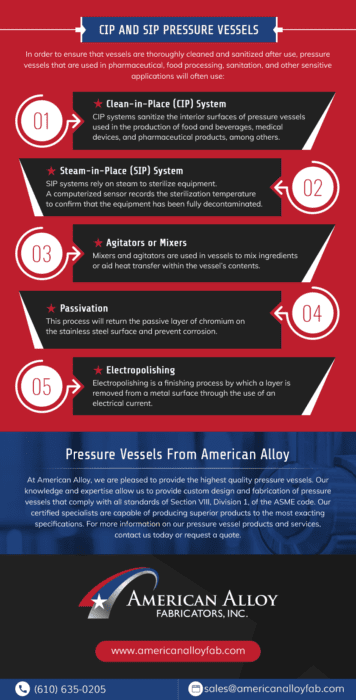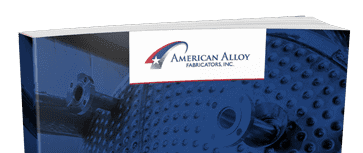Stainless Steel Pressure Vessels
Stainless steel pressure vessels are used to contain liquid or gaseous substances that are under internal or external pressure. The American Society of Mechanical Engineers (ASME) has developed a code to regulate the construction of stainless steel pressure vessels, which delineates the design, fabrication, examination, inspection, testing, and certifications required.
Cylindrical Pressure Vessels
Cylindrical pressure vessels are the most commonly used vessels for storage of high pressure gasses and fluids.
Uses of Stainless Steel Pressure Vessels
Stainless steel pressure vessels are useful for a wide range of applications, including:
- Jacketed Reactors
- Reactors
- Mixing Vessels
- Distillation towers
- Autoclaves
- Heat exchangers
- Vacuum tanks
Common locations where pressure vessels may be found include Pharmaceutical, Cosmetic, Chemical, food processing and dairy processing facilities.
Stainless steel tanks and pressure vessels are composed of a shell, head, and supports, with additional attachments as needed for the vessel’s particular application. Each component of a stainless steel pressure vessel will have a different design and composition based on its intended use.
Pressure Vessel Shells
The “shell” of a stainless steel pressure vessel refers to its wall, which is typically cylindrical. The shell is composed of metal plates with a thickness carefully calculated to sufficiently contain the pressure of the vessel’s contents.
These metal plates are typically made to withstand pressure, as well as the specific types of corrosion commonly caused by the materials it is intended to contain. Materials used for pressure vessel shells include but not limited to:
- Stainless steel
- Hastelloy
- Inconel
- Monel
- Alloy 20
- AL6XN
Pressure Vessel Heads
The head of a stainless steel pressure vessel is the end of the vessel. Stainless steel pressure vessel heads come in a wide range of shapes and sizes, depending on the vessel’s application.
Flat and Flat-Sloping
Flat and flat-sloping heads are the easiest to fabricate, but they aren’t as strong as other head styles. They are constructed flat to the surface of the container and typically used for vessels with smaller diameters in low pressure applications.
Toroconical
Toroconical heads are designed in the shape of a concentric cone, featuring a wide base at the shell and a tapered head. Toroconical heads have a knuckle and straight flange at the wide end of the cone, which makes them more sanitary than concentric cones, but also more expensive to manufacture.
Torispherical
Torispherical heads are semi-hemispherical domes with a knuckle and straight flange at the base. They are also known as ASME flanged and dished. These are the most widely used heads on stainless steel tanks and pressure vessels.
Elliptical
Elliptical heads are similar to torispherical heads, but rather than a perfectly round dome, the depth-to-diameter ratio differs to create an elliptical shape rather than a spherical shape. The base is still characterized by a knuckle and straight flange, and the strength of the design is less than that of a torispherical head as the pressure is not as evenly distributed.
Pressure Vessel Supports
Stainless steel pressure vessels have a wide range of supporting hardware, such as:
- Legs. Legs are the most common support used for stainless steel pressure vessels and are typically mounted at equal distances underneath the container. They are usually composed of I or L channels and are simple and inexpensive to install. Legs also have the added benefit of providing access to the underside of the vessel.
- Sidewall supports. In the event that the vessel cannot be supported from the bottom on a flat surface, it can be bolted to an external frame attached to the sidewall.
- Pad-mounted vessels. A stainless steel pressure vessel will sometimes be mounted on a dedicated pad of poured concrete. This pad may be sloped or leveled as needed for drainage, but on its own does not allow access to the underside of the container.
- Skirt-supported vessels. Similar to the sidewall support, a stainless steel pressure vessel can be supported by the installation of a cylindrical or conical steel skirt attached to the sidewall and mounted on a concrete pad. This can both support the container and protect the underside of the vessel. In addition, it can be used to protect any attachments that exist on the bottom of the container.
- Portable vessels. Stainless steel pressure vessels may be constructed with supports that provide easier portability, including legs and casters. They may also be built onto carts and trolleys with axles and wheels to facilitate easy transport.
- Load cells. Load cells are vessel supports that contain sensors for gauging the weight of the tank. These allow operators to better weigh and measure the contents of a container.
Pressure Vessel Manways
The manway of a stainless steel pressure vessel is the means by which workers can access the vessel. There are a number of design aspects that must be taken into consideration when fabricating a stainless steel pressure vessel manway, such as:
Venting and Relief Devices
In order to prevent collapse of the vessel, ASME codes require that a certified pressure relief device be installed on all stainless steel tanks and pressure vessels. Appropriate relief devices include:
- Safety valves
- Relief valves
- Safety relief valves
- Pressure safety relief valves
- Rupture disks
Depending on the application for which the stainless steel pressure vessel is being used, a combination of devices may be necessary in order to meet ASME Code.
Outlets and Drains
Stainless steel pressure vessels typically contain a drain or outlet at or near the lowest point of the tank. The outlet and joint must be able to withstand the pressure held in the tank to avoid leaks or blowouts. Drains for containers in sanitary services must be placed carefully and at minimal lengths to ensure that the vessel will drain completely.
Heat Transfer Surfaces
When choosing a stainless steel pressure vessel, it is important to understand the amount of potential heat transfer between the exterior environment and the contents of the vessel. This entails in-depth knowledge of the vessel’s contents, the expected temperature at the beginning and end of the process, insulation quantity, and the projected length of time for the process.
There are a wide range of heat transfer surfaces which are useful for a variety of applications, including:
- Mechanical dimpled jacket. A mechanical dimpled jacket surface consists of a sheet of metal uniformly embedded with a pattern of equidistant dimples. The jacket is typically attached to the surface by welds at the bottom of each depression.
- Half-pipe coil. Half-pipe coil jackets consist of metal shaped into concentric circles or coils and welded to the exterior of the container. They are useful for rapid heating or cooling of the contents of the container and are stronger than mechanical dimpled jackets.
- Conventional Jacket. The conventional jacket is a cover over all or part of the vessel with an annular space between the outer vessel wall and the inner jacket wall, generally concentric. This is the most popular jacket
- Insulation and cladding. If stainless steel pressure vessels are equipped with heat transfer jackets, they should be insulated and sheathed or covered in cladding to minimize external environmental influences on the vessel.
CIP and SIP Stainless Steel Pressure Vessels
In order to ensure that vessels are thoroughly cleaned and sanitized after use, stainless steel pressure vessels that are used in pharmaceutical, food processing, sanitation, and other sensitive applications will often use a Clean-in-Place (CIP) or Steam-In-Place (SIP) system.
Clean-In-Place
CIP systems sanitize the interior surfaces of stainless steel pressure vessels used in the production of food and beverages, medical devices, and pharmaceutical products, among others. CIP systems do away with the need to completely disassemble the equipment in order to clean it between uses.
Steam-In-Place
SIP systems rely on steam to sterilize equipment. A computerized sensor records the sterilization temperature to confirm that the equipment has been fully decontaminated. The data is then saved to demonstrate regulatory compliance or for other future references.
Agitators or Mixers
Mixers and agitators are used in vessels to mix ingredients or aid heat transfer within the vessel’s contents. They can also be used to facilitate other mixing processes, including gas dispersion and emulsification.
Cleaning and Passivation
When stainless steel pressure vessels are manufactured for use in sanitary settings, stainless steel should be passivated. This process will return the passive layer of chromium on the stainless steel surface and prevent corrosion.
Electropolishing
Electropolishing is a finishing process by which a layer is removed from a metal surface through the use of an electrical current. This process leaves the surface of the metal smooth—often with a mirror-like finish—and uncontaminated.
Stainless Steel Pressure Vessels From American Alloy
At American Alloy, we are pleased to provide the highest quality stainless steel pressure vessels. Our knowledge and expertise allow us to provide custom design and fabrication of pressure vessels that comply with all standards of Section VIII, Division 1, of the ASME code. Our certified specialists are capable of producing superior products to the most exacting specifications.
For more information on our stainless steel pressure vessel products and services, contact us today or request a quote.







